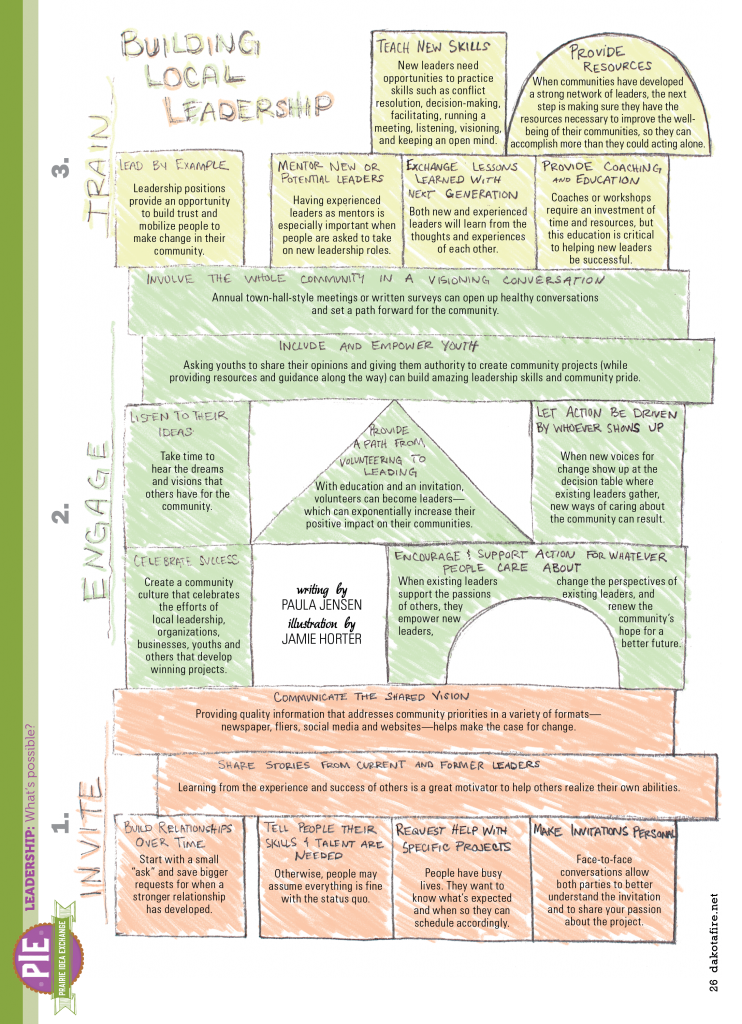By Paula Jensen
Some of us in rural communities feel as if we are missing the secret ingredient to leadership development: We don’t know how to create leaders who are committed long-term. People rise up when there is an immediate need, but then they go away until the next crisis or cause arises.
If there is key ingredient to creating strong community leaders, it’s self-awareness. Becoming truly self-aware means that people understand their own strengths, weaknesses, knowledge, attitudes, opinions and motivation. Our communities can support that path to self-awareness and leadership development by creating a local culture that is open to change, reflective of where we came from, considerate of tradition, and eager to engage all residents from young to old so they can flourish as leaders in the many areas of community life.
The following six strategies can help begin the process of improving self-awareness and creating the communities we want to live in.
- Create Readiness – A community’s level of readiness to produce new leaders in the community is highly dependent on a variety of socioeconomic circumstances that must be considered. For example: Potential new leaders may be facing financial barriers or other challenges that prevent them from volunteering in a leadership role. Established leaders are sometimes uncomfortable sharing power, accepting change, or valuing diverse perspectives. Before a community can develop leaders, established community organizations must recognize these circumstances and work to provide accommodations that will create readiness.
- Create Learning Experiences – New leaders of any age, when given responsibility and opportunities to lead, develop self-awareness and create their leadership capacity simultaneously. Experiential learning happens when we give people leadership roles, engage them in community projects, and provide opportunities to implement their own ideas.
- Create Mentors – Mentoring requires an investment of time and resources, but this one-on-one support strategy is critical for new leadership to be successful. Mentoring is especially needed when people are asked to take on leadership roles and operate in an environment that may be unfamiliar to them.
- Create Skills – Communities can host trainings that assist in developing needed leadership skills such as conflict resolution, decision-making, fundraising, grant writing, facilitating, creating an agenda, leading a meeting, listening, mediating, keeping an open mind, goal setting, partnership development, public speaking, and visioning.
- Create Trust – Communities with strong relationships built on trust and an established network of partners, resource providers, leaders, and local citizens are more capable of working together to improve the overall socioeconomic well-being of their community and to accomplish more than they ever could have imagined acting alone.
- Create Knowledge – Communities must create quality information strategies that address community priorities. This network of knowledge is a powerful tool for making the case for change in your community and provides an invitation for new leadership to rise. Sharing knowledge and information to the general community and other organizations in a useful format such as websites, newspapers, social media, and person-to-person is highly effective in rural communities.
Creating new leadership is possible, and it’s worth the effort. Some impacts of new leaders are quantifiable, such as new policies, new programs established, and projects completed. Other impacts will be more difficult to measure, but are just as important: self-awareness, personal empowerment, changes in attitudes and perspectives of existing leaders, and a renewed commitment and hope in the community for creating a better future.
 Dakotafire Get your spark here.
Dakotafire Get your spark here.




